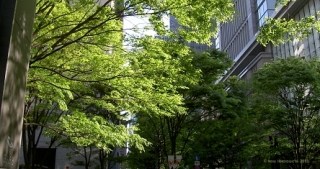‘The Book of Tea’_012
2013年1月24日 Leave a comment

I. The Cup of Humanity ― 人間の器
The earliest record of tea in European writing is said to be found in the statement of an Arabian traveller, that after the year 879 the main sources of revenue in Canton were the duties on salt and tea. Marco Polo records the deposition of a Chinese minister of finance in 1285 for his arbitrary augmentation of the tea-taxes. It was at the period of the great discoveries that the European people began to know more about the extreme Orient. At the end of the sixteenth century the Hollanders brought the news that a pleasant drink was made in the East from the leaves of a bush. The travellers Giovanni Batista Ramusio (1559), L. Almeida (1576), Maffeno (1588), Tareira (1610), also mentioned tea. In the last-named year ships of the Dutch East India Company brought the first tea into Europe. It was known in France in 1636, and reached Russia in 1638. England welcomed it in 1650 and spoke of it as “That excellent and by all physicians approved China drink, called by the Chineans Tcha, and by other nations Tay, alias Tee.”
ヨーロッパ人の手になる最も初期の茶に関する記録は、「879年以降、中国(唐)の広東の歳入は、塩と茶の課税によって賄われている(注*)」と書かれたアラビアへ行った旅行者による報告書だと言われています。また、「東方見聞録」で著名なイタリア人の旅行家マルコポーロは、1285年、中国(元)の蔵相が茶の税率を専断したため罷免された、と記録しています。
極東(東アジアと東南アジアの地域)について西欧人がより知識を持つようになったのは、大航海時代(「発見時代」とも呼ばれています)のことです。16世紀の終わり頃(日本は戦国時代末期、中国は明末)、オランダ人が「東洋には密林の樹木の葉を用いて喫する心地よい飲料(=「茶」のこと)がある」という報告を西洋にもたらしました。以後、1559年にジョバンニ・バティスタ・ラムシオ(イタリアの地理学者で旅行家)、1576年にポルトガル人のL.アルメイダ、1588年のマッフェノ、1610年にはタレイラら西欧の旅行家たちも茶について言及した報告を行っています。そして、タレイラが東洋の茶の報告をしたこの年、1610年、オランダ東インド会社の商船がヨーロッパに茶を初めて持ち込んで後、1636年にはフランス、1638年にはロシアに伝播しました。
英国では、1650年、「この気味合い高き崇高な、しかも、お医者殿が青ざむるほど健康に優れしと太鼓判を押されたる、かの地の果て海の彼方の極東・中国よりはるばる伝来したるこの飲みもの、これ何と申すと人問はば、教えて進ぜん、彼の国シーナの人々、これを<ッチャー>、またその他アジアの国の人々が<チャイ>あるは<テー>と申すものなり」と喧伝され、茶の風習は英国社会に歓迎され、溶け込んで行きました。
注*
このころ中国は「唐」の末期で、黄巣の乱(875~884)によって国内は混乱を極めていた。この乱の首謀者の王仙芝も黄巣も闇塩の密売商であった。また日本は、平安京に遷都(794)して80年ほどが経過し、国風文化の栄える藤原摂関政治が始まった頃の平安時代初期に当たる。また当時(7世紀から15世紀末まで)のアラビアは、インドの西部からアラビア半島・アフリカ北部・イベリア半島まで版図としたサラセン(イスラム教徒)が支配していた地域の一部で、ムハンマド(マホメット)の後継者(カリフ)が、その地位を得るたびに王朝の交替が繰り返されていた。
▼▽▼▽▼ 掲載日 ▼▽▼▽▼
25jan2013



![Takashi Ikenouchi [Shūson] / 池ノ内 孝 [秋村]](https://kouikenouchi.wordpress.com/wp-content/uploads/2017/03/2017600317wb01a.jpg?w=312)


